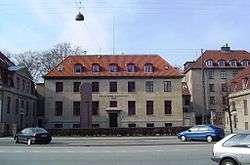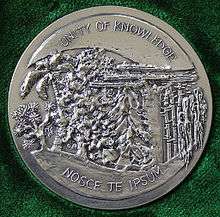Niels Bohr Institute
Coordinates: 55°41′48.29″N 12°34′16.80″E / 55.6967472°N 12.5713333°E

The Niels Bohr Institute (Danish: Niels Bohr Institutet) is a research institute of the University of Copenhagen. The research of the institute spans astronomy, geophysics, nanotechnology, particle physics, quantum mechanics and biophysics.
Overview
The Institute was founded in 1921, as the Institute for Theoretical Physics of the University of Copenhagen, by the Danish theoretical physicist Niels Bohr, who had been on the staff of the University of Copenhagen since 1914, and who had been lobbying for its creation since his appointment as professor in 1916. On the 80th anniversary of Niels Bohr's birth – October 7, 1965 – the Institute officially became the Niels Bohr Institute.[1] Much of its original funding came from the charitable foundation of the Carlsberg brewery, and later from the Rockefeller Foundation.[2]
During the 1920s, and 1930s, the Institute was the center of the developing disciplines of atomic physics and quantum physics. Physicists from across Europe (and sometimes further abroad) often visited the Institute to confer with Bohr on new theories and discoveries. The Copenhagen interpretation of quantum mechanics is named after work done at the Institute during this time.
On January 1, 1993 the institute was merged with the Astronomic Observatory, the Ørsted Laboratory and the Geophysical Institute. The new resulting institute retained the name Niels Bohr Institute.
Research sections
Research at the Niels Bohr Institute is organised in ten research sections covering a broad range of physics, i.e. astrophysics, biophysics, solid state physics, geophysics, particle physics and e-science.
Medal of Honour


in 2010, the year of the 125th anniversary of the birth of Niels Bohr, the Institute established the Niels Bohr Institute Medal of Honour. It is an annual award for "a particularly outstanding researcher who is working in the spirit of Niels Bohr: International cooperation and the exchange of knowledge".[3]
The medal is made by Danish sculptor Rikke Raben for the Niels Bohr Institute. On the front is a portrait of Niels Bohr, the atom sign and stars. The illustration on the back is inspired by a quote from Bohr: What is it that we human beings ultimately depend on? We depend on our words. We are suspended in language. Our task is to communicate experience and ideas to others.[4] On the back of the medal: Unity of Knowledge – the title of a lecture given by Bohr at Columbia University in 1954. Nosce te ipsum is Latin and means "know thyself". This quote originates from the Oracle of Delphi, in the Temple of Apollo in Greece.
Recipients:
- 2010: Leo Kadanoff[5]
- 2011: Andre Geim[6]
- 2012: Juan Ignacio Cirac Sasturain[3]
- 2013: Fabiola Gianotti[7]
- 2014: Glaciologist Jérôme Chappellaz[8]
- 2015: Astrophysicist Brian Schmidt[9]
- 2016: Gerard 't Hooft[10]
See also
External links
References
- ↑ "Bohr Institute" in John L. Heilbron, The Oxford Companion to the History of Modern Science (Oxford University Press, 2003), ISBN 978-0199743766, pp. 103–104. Excerpts available at Google Books.
- ↑ Abraham Pais, "Physics in Denmark: The First Four Hundred Years", lecture delivered March 6, 1996, reprinted at Nobelprize.org, February 21, 2002.
- 1 2 Professor Ignacio Cirac receives the Niels Bohr Institute Medal of Honour, Niels Bohr Institute, January 9, 2013
- ↑ Aage Petersen, 'the philosophy of Niels Bohr' in Bulletin of the Atomic Scientists, 1963, XIX,7, p.10. It is quoted on the inside of the medal box.
- ↑ Leo Kadanoff receives the Niels Bohr Institute's first honorary medal, Niels Bohr Institute, June 21, 2010
- ↑ Andre Geim receives Niels Bohr Institute Medal of Honour, Niels Bohr Institute, December 8, 2011
- ↑ Fabiola Gianotti receives the Niels Bohr Institute's honorary medal, Niels Bohr Institute, November 1, 2013
- ↑ Jérôme Chappellaz receives the Niels Bohr Institute's medal of honour, Niels Bohr Institute, November 26, 2014
- ↑ Brian Schmidt receives the Niels Bohr Institute Medal of Honour, 2015, Niels Bohr Institute, January 29, 2016
- ↑ Gerard ’t Hooft receives the Niels Bohr Institute Medal of Honour, 2016 Archived December 2, 2016, at the Wayback Machine., Niels Bohr Institute, November 30, 2016